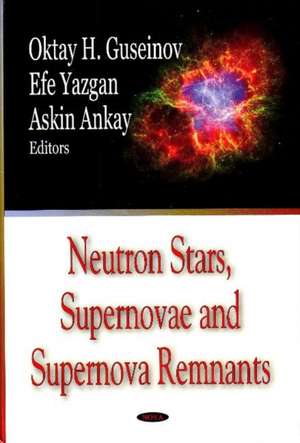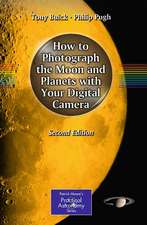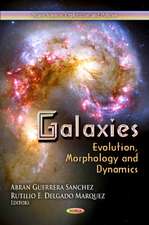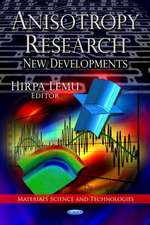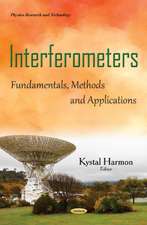Neutron Stars, Supernovae & Supernova Remnants
Autor Oktay H Gusienov, Efe Yazgan, Askin Ankayen Limba Engleză Hardback – feb 2007
Preț: 961.91 lei
Preț vechi: 1316.08 lei
-27% Nou
Puncte Express: 1443
Preț estimativ în valută:
184.08€ • 191.09$ • 153.50£
184.08€ • 191.09$ • 153.50£
Carte disponibilă
Livrare economică 04-18 martie
Preluare comenzi: 021 569.72.76
Specificații
ISBN-13: 9781600215483
ISBN-10: 1600215483
Pagini: 187
Ilustrații: tables & charts
Dimensiuni: 260 x 180 x 18 mm
Greutate: 0.59 kg
Editura: Nova Science Publishers Inc
Colecția Nova Science Publishers, Inc (US)
ISBN-10: 1600215483
Pagini: 187
Ilustrații: tables & charts
Dimensiuni: 260 x 180 x 18 mm
Greutate: 0.59 kg
Editura: Nova Science Publishers Inc
Colecția Nova Science Publishers, Inc (US)
Cuprins
Neutron Stars; Introduction; Development of the Physics, Degenerate Stars and the First Steps in Estimating Neutron Star Mass; The Main Steps in Constructing Neutron Star Models and their Origins; Searches of Neutron Stars and Black Holes; Neutron Stars and Black Holes in X-ray Binaries; Main Physical Properties; Discussion and Conclusions. Core Collapse Supernovae; The Collapse and the Explosion; Neutrino Emission; Rotation, Asymmetry, Anisotropy and Magnetic Fields; Wind from Accretion Disk; Neutrino Oscillations and the Neutrino Signal from SN 1987A; Fall-Back Disks; Conclusion. The Magnetic Field of Pulsars; Introduction; Superfluidity of Hadronic Matter; Superfluidity of Nuclear Matter in Neutron Star; Vortex Structure of the Neutron Superfluid as a Consequence of Rotation; Entrainment Effect in the Hadronic Core of a Star; Theory of Superfluidity in a Two-component Fermi System near the Phase Transition Temperature Phase Transition Temperature; Three-velocity Magnetohydrodynamics of Super Fluid Solutions; Magnetic Field Generation in Pulsars; London Equation for a Superfluid Solution; Gibbs Free Energy for a Two-component Superfluid; Clusters of Proton Vortices in a Neutron Vortex; Average Density of Neutron Vortices and Average Magnetic Induction of the Star; Vortex-free Zone; The Structure of the Magnetic Field of a Neutron Star; Superconductivity of Quark Matter; Solution of Ginzburg-Landau Equations for "2SC" Phase; The Magnetic Field Components; Free Energy of "CFL" Phase; Ginzburg-Landau Equations for the "CFL" Phase; Vortex Structure in "CFL" Phase; Solution of Ginzburg-Landau Equations in "CFL" Phase; The Magnetic Field Components in "CFL" Phase; Conclusion. Evolutions of Neutron Stars and their Magnetic Fields; Introduction; Radio Pulsars; Recycled Radiopulsars; Magnetic Field Damping During Accretion; Formation of Single Recycled Pulsars: Enhanced Evaporation; X-ray Binaries; Relativistic Dipole Interpretation of the Spectral Feature in Her X-1; Cyclotron Harmonics in the X-ray Pulsars; Magnetars; Discussion; Conclusions. Supernova Remnants in Nearby Galaxies; Introduction; Emission of SNRs in Different Frequency Domains; Radio SNRs in Nearby Galaxies; Introductive Remarks for 11 Nearby Galaxies with Identified Radio SNRs; The Sample of Radio SNRs in Nearby Galaxies; Optical and X-ray SNRs in Nearby Galaxies; Combination of Radio, Optical and X-ray Data Sets; Summary. Connections between Supernova Remnants, Neutron Stars and Supernovae; Introduction; The Frequency of Supernova Explosions and the Birth Rates of Different Types of Neutron Stars in our Galaxy; What is known about the Chemical Abundances from Optical Observations of Supernova Remnants?; Examination of Differences between C- and S-type Supernova Remnants and the Supernova Remnants which Contain Different Types of Neutron Stars Together with the Supernova Remnants which possibly lack any Point Sources; Stellar Collapse, Neutrino Radiation and Supernova Explosion; Discussion and Conclusions. Index.
